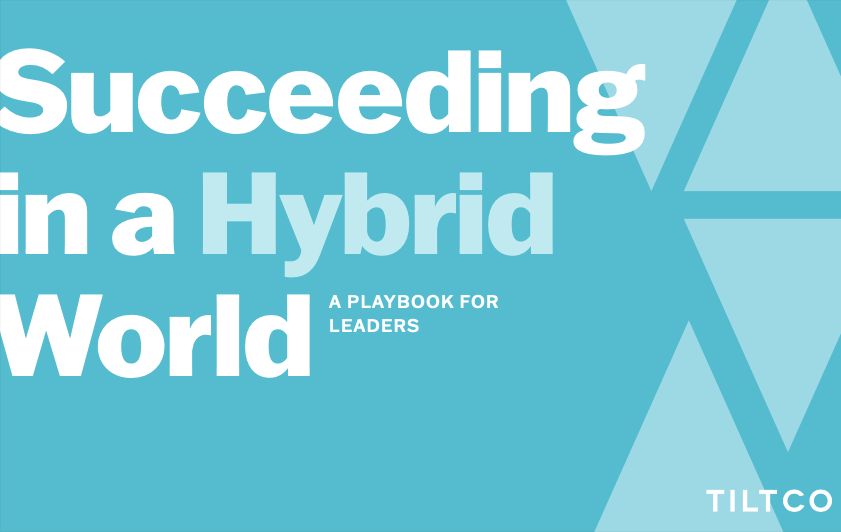5 ways leaders can support their middle managers in a hybrid workplace

TILTCO held a series of roundtable discussions in January and February 2021. Attended by business leaders, consultants, academics and experts, the discussions gathered insights and practical ideas to help leaders reimagine their organizations as we emerge from the Covid-19 pandemic.
Hybrid work environments are not new. Many fields, like professional services, have been experimenting with these models for years with varying levels of success. What is new is the number of organizations, industries and levels of roles that are considering adopting hybrid models of work – where there is a mix of remote and in person work happening. As many leaders consider these models, they are beginning to ask the question: “How do we make hybrid great?”
The benefits of hybrid are clear – access to broader talent, flexibility for employees, economic savings through less physical space. Yet, the inherent complexity of managing team members across settings is real. Core to navigating this complexity are middle managers.
In our latest TILTCO Roundtable participants discussed 5 things leaders need to “get right” to ensure the success of their managers in leading hybrid teams.
1. Reset expectations for how work happens that works for in-office and remote workers
Success starts with clear and intentional norms for the new work context. These norms, as discussed in our first Roundtable, do not simply mean replicating in-person work and behaviours into the hybrid model. It requires really thinking about what practices can continue, what needs to be adjusted and what needs to be introduced.
These norms or behaviours, the Roundtable agreed, need to be practical and address specific issues. Suffer from back-to-back meetings? Limit meetings to 50 minutes. Keen to allow people flexibility to integrate life and work, but want to make sure others aren’t stalled? Set official team hours where there are clear rules on responding to emails, calls and texts. Once these norms are established, make sure they work and create a consistent experience for those working together and those working remotely.
“Managers will have to deliberately put themselves in the shoes of each of the different people on their team. So, one week, they’ll attend the meeting from the boardroom with others on the team and then join remote the next week to see how it feels from that perspective,” explained Reid Wuntke, president of Energy Toolbase.
2. Empower managers with technology
Providing managers with the right technology to do their job was identified as a non-negotiable. Amanda Setili, president of Setili & Associates, explained: “Building trust can be difficult when working remotely, but employees can more easily build trust when they look directly at the camera when speaking. Therefore, teaching them how to position their camera at eye level in front of the screen is key. Supplemental lighting also helps employees look professional and approachable. Managers who provide the right technology and coach on skills like this will help their team perform better.”
Other technologies are required to help teams engage and get work done. For this group, it was important to set clear expectations as it was to train managers to use these technologies to their full potential. Reid offered another opportunity: “There’s an ancillary benefit by empowering your middle managers to define corporate tools for their own teams. You build trust and you help their teams thrive.”
3. Redefine the role of manager and train them to succeed
The only way for a hybrid model to function successfully, is for managers to have complete clarity on their role. Lisa Dymond, partner and head of talent at Atlas Partners, says this starts with “setting the guardrails and being very, very specific around expectations. The greatest risk in a hybrid workplace is that expectations are not clear right at the start.”
In the hybrid context, managers can no longer be supervisors of time. Instead, they will need to manage relationships, ensure pace and quality are not compromised, and play a central role in connecting individuals to each other and to the organization. This transition was already underway, but the hybrid workplace will accelerate the focus of setting managers up to be true people leaders.
“Succeeding in hybrid remote/in-person work environment requires a lot from managers. It’s a new way of leading and thinking about their job that they can’t entirely transition to on their own,” explained Susan Charnaux, principal and founder at Fairhill Ventures.
This will require investing differently in manager training, focusing on more foundational skills in delegation, personal resiliency and leading in uncertainty. “You have to show managers that it matters, that they should want to change and need to change. Coach them and then give them a checklist: have you checked in with your employee, how open is your communication, how independently are they working, and so on. It’s simple, but it showcases what they should be striving towards,” shared Nils Boeffel, freelance consultant for digital strategy and agile transformation.
4. Prepare your managers to take on the human side of leadership.
The hybrid model provides compelling flexibility to employees. It also presents the potential downside where employees have less time to build meaningful relationships with each other, their manager and the organization. The group agreed this begins with trust.
“Managers need to explicitly talk about trust. It can be as simple as ending a meeting by offering a simple framework on trust and asking the team to rate themselves based on it. Sometimes even bringing up the topic openly creates a bit of trust,” explained Aneta Key, strategic growth advisor at Aedea Partners LLC.
The importance of employee well-being was also highlighted. The emphasis on physical and mental health will endure past the pandemic. “There’s going to be a whole new wave of challenges that they may not have experienced or have the tools to deal with,” explained Lisa. “So, leaders need to think about how we arm our middle managers to have difficult conversations.”
5. Remember: success of hybrid starts with you.
“For leaders, there’s something about being very aware of decisions that you’re making and consider what that may look like to others, especially as it might be opposite to the culture or the messaging that you’re trying to get out there,” said Kelly Duffin, experienced strategy and transformation leader.
The idea of role modelling was a key theme during the Roundtable discussion. “People have this mindset that you have to pour all your energy and time to work, work, work and end up burning themselves out,” explained Aneta. To shift this way of thinking she often shares a mantra with her clients: “When I take care of myself and my team, I take care of business.”
In addition to a mantra, leaders can demonstrate how managers can care for their teams by taking care of their managers: “We’re seeing burnout among middle managers. If you’re a leader, create space for your managers, spend time with them as individual, checking in on how they are doing, sharing some of your own frustrations and offering the coaching they need,” said Susan.
Listen in to our upcoming LeaderLab Podcast that shares more insights and perspectives from this Roundtable. And stay tuned for insights from our second roundtable that will focus on how leaders can effectively support their middle managers to lead in a hybrid environment.

Download the Leader Playbook to access practical insights and ideas that will help you be a better leader in a hybrid context.
We thank our guests for their time and insights: Nils Boeffel, Susan Charnaux, Kelly Duffin, Aneta Key, Amanda Setili, Lisa Dymond, and Reid Wuntke.
A special thank you to Will Bachmann and Umbrex for their help in bringing these roundtables together.